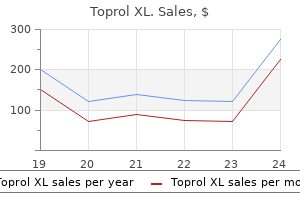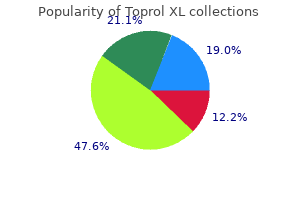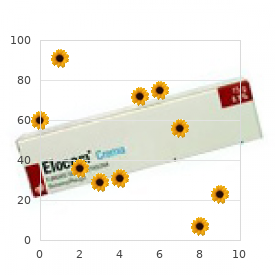Only $0.58 per item
Toprol XL dosages: 100 mg, 50 mg, 25 mg
Toprol XL packs: 30 pills, 60 pills, 90 pills, 120 pills, 180 pills, 270 pills, 360 pills
In stock: 973
9 of 10
Votes: 29 votes
Total customer reviews: 29
Description
IntheUnitedStates can high blood pressure medication cause joint pain discount toprol xl 100 mg fast delivery, because manufacturers discontinued diphtheria antitoxin production in 1997,nolicensedproductisavailable. A history of travel to a region with endemic diphtheria or a history of contact with a recent immigrant from such an area increases the suspicion of diphtheria, as does a pre-antitoxin treatment serum antitoxin level of less than 0. The goals of treatment are to neutralize the toxin rapidly,eliminatetheinfectingorganism,providesupportivecare,andprevent furthertransmission(Table292-1). Antibiotictherapy,by Immunization with diphtheria toxoid is the only effective means of primary prevention. The primary series is four doses of diphtheria toxoid (given with tetanus toxoid and pertussis vaccine) at 2, 4, 6, and 15 to 18 months; a preschool booster dose is given at 4 to 6 years of age. Thereafter, boosters should be given as part of the adolescent immunization visit. Diphtheria, at the beginning of the 21st century, remains a serious disease associated with a high case-fatality rate. The pathogenic potential of many of these organisms was not appreciated in the past, but many are now known to be associated with specific and often serious infectious diseases, especially in immunosuppressed, chronically ill, and hospitalized patients Table 292-2). In general, these organisms remain susceptible to vancomycin, but resistance to other classes of antimicrobials is common and varies among species. Presently, the annual incidence of listeriosis is 3 cases per million population, and it accounts for 1800 cases per year and about 400 deaths. However, as many as a fourth of all cases of invasive listeriosis occur in apparently healthy persons, particularly those older than 60 years. Mother-to-child transmission occurs transplacentally or through an infected birth canal. Within the host cell, the bacterium is enclosed in a phagolysosome, but through the production of an exotoxin called listeriolysin O, it destroys the phagolysosome membrane and gains access to the cytoplasm. Listeriae actively divide in the cytoplasm, migrate to the periphery of the cell by polymerization of host cell actin, and then push out the cell membrane to form pseudopods, which are taken up by adjacent host cells. The bacteria move from cell to cell in this fashion and repeat their life cycle without exposure to antibodies or complement. Immunity to listerial infection is handled chiefly through the cell-mediated arm of the immune system. Persons who have had splenectomy or have abnormalities solely of humoral immunity or leukocytes are not at increased risk for infection. Most patients have impaired cell-mediated immunity and are seen with life-threatening bacteremia or meningitis.

True Unicorn root (Aletris). Toprol XL.
- Dosing considerations for Aletris.
- How does Aletris work?
- Are there safety concerns?
- Are there any interactions with medications?
- Joint, muscle, and tendon pain; female disorders; constipation; gas; colic; diarrhea; menstrual disorders; and other conditions.
- What is Aletris?
Source: http://www.rxlist.com/script/main/art.asp?articlekey=96600
Central nervous system shunt infection Answer: E Propionibacterium species are part of the normal bacterial flora that colonizes the skin hypertension jnc 8 pdf buy 50 mg toprol xl fast delivery, conjunctiva, oropharynx, and gastrointestinal tract. These nonspore-forming, anaerobic, gram-positive bacilli are frequent contaminants of specimens of blood and other sterile body fluids and have been generally considered to play little or no pathogenic role in humans. Propionibacterium acnes has, however, been recovered in specimens obtained from patients with infections associated with a foreign body (such as an artificial valve), endocarditis, and central nervous system shunt infections. These structures provide mobility ("twitching motility") to penetrate mucus and are the initial adhesins for human epithelial cells. Meningococci proceed to proliferate on the surface of human nonciliated epithelial cells, forming small microcolonies at the site of attachment; they can disseminate from colonies by post-translational glycan modifications of pili and migrate to adjacent cells by the pili-mediated motility. Other less common local infections include conjunctivitis, urethritis, and proctitis. Close adherence of meningococci to the host epithelial cells results in the formation of epithelial cell cortical plaques and leads to the recruitment of factors ultimately responsible for the formation and extension of host epithelial cell pseudopodia that can surround the meningococcus. However, other meningococcal epithelial cell mediators include the meningococcal adhesin NadA and meningococcal lipo-oligosaccharide. Intracellular meningococci reside within a membranous vacuole and are capable of translocating through the epithelial layers within 18 to 40 hours. Meningococci are capable of intracellular replication (in part because of the protective capsule), can survive under microaerophilic conditions, use lactate as a carbon source, and have the capacity to acquire iron through specialized transport systems. Meningococci cross mucosal surfaces, enter the blood stream, and, in some individuals, produce systemic infections. Similar molecular interactions noted for meningococci and epithelial cells also occur with endothelial cells, and meningococci can translocate across the blood-meninges barrier, possibly at the choroid plexus or by opening of intercellular junctions, and proliferate in the subarachnoid space, resulting in meningitis. Meningococcal endotoxin released in blebs plays a major role in the inflammatory events of meningococcemia and meningococcal meningitis. Meningococcal lipid A is responsible for much of the biologic activity and toxicity of meningococcal endotoxin. Meningococcal carriage is affected by age, intimate personal contact, crowding. Meningococcal carriage is a dynamic process, is less common in young children (<3% and Neisseria lactamica predominates) than in older children, is highest in adolescents (7 to 37%), and increases in closed populations. Carriage can be transient or last for days, weeks, or months and is an immunizing event leading to protective immunity. Disappearance of protective maternal antibodies increases the risk in older infants and young children. Opsonization and phagocytic function do contribute to meningococcal host defense mechanisms, as shown by disease reduction after polysaccharide vaccination in individuals with complement deficiencies.

Specifications/Details
Once the virus initiates infection of the respiratory tract epithelium blood pressure chart high systolic low diastolic purchase toprol xl 50 mg online, successive cycles of viral replication infect large numbers of cells and result in destruction of respiratory epithelium and sometimes pneumocytes through direct cytopathic effects or apoptosis. The incubation period averages 2 days and varies from about 1 to 4 days for seasonal influenza but may be up to 1 week and possibly longer in infections caused by avian viruses. The quantity of virus in respiratory tract specimens generally correlates with the severity of illness and levels of host pro-inflammatory cytokine-chemokine responses-findings that support the importance of ongoing viral replication in producing acute illness. The duration of viral replication depends on age, immune status, underlying conditions, viral strain, and assay method. In seasonal influenza, upper respiratory viral detection generally continues for 3 to 5 days in adults but is longer in the elderly and hospitalized patients and may persist for weeks to months in immunocompromised hosts. Higher level and more prolonged viral replication, sometimes for weeks, occurs in the lower respiratory tract of patients with viral pneumonia, including pandemic 2009 and avian H5N1 and H7N9 infections. Viremia or extrapulmonary dissemination is rarely detected in typical human influenza, but both occur in some patients with avian H5N1 infections, in whom gastrointestinal replication may also occur. Nasal and bronchial biopsy specimens from persons with uncomplicated influenza reveal desquamation of the ciliated columnar epithelium and loss of cilia. The lungs in fatal influenza may show necrotizing bronchitis, diffuse alveolar damage with epithelial necrosis, alveolar edema and hemorrhage, and hyaline membrane formation, followed later by squamous metaplasia and fibrosis. Secondary bacterial infections develop as a result of altered bacterial flora, damage to bronchial epithelium with depressed mucociliary clearance, decreased polymorphonuclear and alveolar macrophage functions, accumulation of alveolar fluid, and suppression of other host immune responses. Humoral immunity to influenza appears to be largely subtype specific and durable for a particular strain. The virus spreads worldwide, often circulating outside of the usual influenza season, and usually infects persons of all ages. Preexisting immunity due to prior infection with antigenically related viruses can provide partial protection, as occurred in older adults during the 2009 H1N1 pandemic. Pandemics are associated with high morbidity rates, especially in children, and sometimes notably increased mortality rates in pregnant women and young and middle-aged adults. For example, more than 90% of deaths in the 1918 and 2009 pandemics occurred in persons younger than 65 years. The most severe pandemics have been associated with major antigenic alterations in both major surface antigens. Depending on population susceptibility and perhaps changes in the virus, one or more waves, sometimes with increased severity, may follow the initial one. As the level of immunity in the population increases, antigenic drift within the subtype may cause repeated epidemics in subsequent years, and excess mortality in persons younger than age 65 may continue for some years. For example, the pandemic 2009 H1N1 virus has continued to cause fatal infections in younger adults at least 4 years after its initial emergence. Zoonotic Influenza Zoonotic infections may be acquired from swine, poultry, or rarely other animals. Although most avian influenza viruses do not cause infections directly in humans, zoonotic infections due to avian H5, H7, H9, and rarely other subtypes continue to represent potential threats to global health. Initially recognized by a cluster of human cases in Hong Kong in 1997, an epizootic of avian H5N1 infections has affected poultry in many areas of Asia, the Middle East, Europe, and Africa and continues to cause sporadic human illnesses with high mortality and occasional instances of nonsustained human-to-human transmission.
Syndromes
- Chills
- Dental x-rays
- Rainbow-colored rings around lights
- Burns of the food pipe (esophagus)
- Swallowing difficulty
- Foggy or blurred vision, at first only in the mornings

Antibodies to human adeno-associated viruses hypertension guidelines canada 25 mg toprol xl fast delivery, which are dependoparoviruses that are used as gene therapy vectors, occur naturally in humans, but B19 is the only parvovirus known to be pathogenic in humans. B19 infection is global; infectivity rates, inferred from the presence of antiparvovirus IgG antibody in sera, are similar worldwide. In adult volunteers inoculated intranasally with B19, nonspecific influenzalike complaints occurred early along with viremia; the cutaneous eruption a week later corresponded to the appearance of antiviral antibodies. These more specific symptoms of B19 parvovirus infection are secondary to immune complex formation and deposition. Serologic testing generally shows seroconversion, IgM antibody or the appearance of IgG antibody to parvovirus. The rash of fifth disease may be evanescent, and recurrences can be provoked by sunlight, heat, emotion, or exercise. In adults, the rash is less characteristic, can present as palpable purpura, may be associated with pruritus in up to 50% of patients,3 and can be difficult to visualize in dark-skinned individuals. Treatment-related progressive multifocal leukoencephalopathy: current understanding and future steps. Brain imaging usually shows progressive increase in the size of the ventricles, as well as ependymal and meningeal enhancement. In contrast to the mild course in children with fifth disease, acute parvovirus infection in adults, particularly middle-aged women, may cause significant arthropathy. Symmetrical joint involvement of the hands, ankles, knees, and wrists can resemble rheumatoid arthritis (Chapter 264), and the test result for rheumatoid factor may be positive. B19 arthropathy usually resolves within a few weeks; joint destruction does not occur. Parvovirus is not the cause of rheumatoid arthritis, but case reports suggest that B19 infection may mimic, precipitate, or worsen a variety of rheumatologic diseases, including juvenile rheumatoid arthritis, systemic lupus erythematosus, and fibromyalgia. B19 Arthropathy Transient Aplastic Crisis In persons with underlying hemolysis or a high demand for production of circulating erythrocytes, acute B19 parvovirus infection causes transient aplastic crisis, an abrupt cessation of red blood cell production that exacerbates or, in previously compensated states, provokes severe anemia. Erythropoiesis is temporarily suppressed in all B19 parvovirus infections, but hemoglobin levels remain stable because of the long lifespan of erythrocytes. The anemic crises associated with low or absent reticulocytes in hereditary spherocytosis and sickle cell disease are virtually always secondary to B19 parvovirus infection. Parvoviremia is present in patients with transient aplastic crisis, and red cell production resumes once antibodies to the virus are produced and the infection is cleared. Although it is self-limited, aplastic crisis often requires transfusion and can lead to severe, occasionally fatal anemia that precipitates congestive heart failure and cerebrovascular accidents. White blood cell and platelet counts may fall modestly during transient aplastic crisis, especially in patients with functioning spleens. Occasional cases of agranulocytosis may be due to B19; thrombocytopenia and pancytopenia have been reported, and B19 can precipitate a benign virus-associated hemophagocytic syndrome. Patients do not develop the clinical features of fifth disease but instead have an entirely hematologic syndrome of pure red cell aplasia. The anemia is severe and requires transfusion; reticulocytes are absent from blood, as are erythroid precursors from marrow.
Related Products
Additional information:
Usage: ut dict.

Tags: discount toprol xl 100 mg mastercard, generic toprol xl 100 mg, cheap toprol xl 100 mg with amex, generic toprol xl 50 mg without prescription
Customer Reviews
Oelk, 47 years: They may therefore be the only test with a positive result in patients with cardiovascular or neurologic syphilis.
Lars, 52 years: A small inoculum can cause severe pulmonary infection or progress to acute symptomatic disseminated histoplasmosis in immunosuppressed patients.
Enzo, 62 years: In older infants and children, an abrupt onset of fever is the most frequent initial symptom.
Malir, 30 years: Such decisions, however, require careful discussion between the physician and the patient.
Bozep, 60 years: Two months later, he now has developed several days of severe nausea and vomiting and is unable to keep his medications down.
Domenik, 50 years: The American Academy of Pediatrics recommends slow-release products below 30% concentration.



